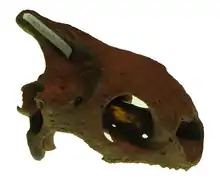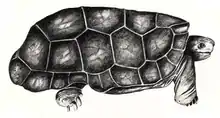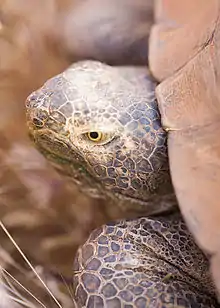Cylindraspis
Cylindraspis is a genus of recently extinct giant tortoises. All of its species lived in the Mascarene Islands (Mauritius, Rodrigues and Réunion) in the Indian Ocean and all are now extinct due to hunting and introduction of non-native predators.

| Cylindraspis | |
|---|---|
_(19965220184)_1.jpg.webp) | |
| Lithograph of a taxidermied specimen of Cylindraspis vosmaeri | |
| Scientific classification | |
| Kingdom: | Animalia |
| Phylum: | Chordata |
| Class: | Reptilia |
| Order: | Testudines |
| Suborder: | Cryptodira |
| Superfamily: | Testudinoidea |
| Family: | Testudinidae |
| Genus: | †Cylindraspis Fitzinger, 1835 |
They are not closely related to any extant group of tortoises, having diverged from the largely African clade including Chelonoidis, Geochelone, and Astrochelys around 40 million years ago during the Eocene, most likely in Africa. The split between within the genus is also deep, with the split between C. triserrata and all other members of the genus being estimated at around 28 million years ago, during the Oligocene, before the current Mascarene Islands were even formed, meaning that the genus must have colonised the Mascarenes by island hopping from now submerged paleoislands formed by the Réunion hotspot as part of the Mascarene Plateau, including the Saya de Malha Bank and Nazareth Bank.[1]
Human settlers colonised the Mascarenes in 1663. These giant tortoises were very large and slow, thus making them easy game. Like many island species, they were also reported to have been friendly and unafraid of humans. Most species of this genus were already driven to extinction by 1795 and the last individuals were reputed to have died around 1840 (Arnold 1979, Bour 1980, Cheke and Hume 2008).
Species
The genus contains at least the following species:
- †C. indica, Réunion giant tortoise, also known by the synonym Cylindraspis borbonica, from Réunion
- †C. inepta, saddle-backed Mauritius giant tortoise, from Mauritius
- †C. peltastes, domed Rodrigues giant tortoise, from Rodrigues
- †C. triserrata, domed Mauritius giant tortoise, from Mauritius
- †C. vosmaeri, saddle-backed Rodrigues giant tortoise, from Rodrigues
 Cylindraspis indica
Cylindraspis indica C. peltastes
C. peltastes C. vosmaeri
C. vosmaeri
References
- Kehlmaier, Christian; Graciá, Eva; Campbell, Patrick D.; Hofmeyr, Margaretha D.; Schweiger, Silke; Martínez-Silvestre, Albert; Joyce, Walter; Fritz, Uwe (2019-11-25). "Ancient mitogenomics clarifies radiation of extinct Mascarene giant tortoises (Cylindraspis spp.)". Scientific Reports. 9 (1). doi:10.1038/s41598-019-54019-y. ISSN 2045-2322. PMID 31767921.
- Arnold, E.N. 1979. Indian Ocean giant tortoises: their systematics and island adaptations. Philosophical Transactions of the Royal Society of London B Biological Sciences 286 (1011): 127-145
- Austin, J.J., Arnold, E.N. (2001). Ancient mitochondrial DNA and morphology elucidate an extinct island radiation of Indian Ocean giant tortoises (Cylindraspis). Proceedings: Biological Sciences, Volume 268, Number 1485, Pages: 2515–2523.
- Bour, R. 1980. Systematique des tortues terrestres des iles Mascareignes: genre Cylindraspis Fitzinger, 1835 (Reptilia, Chelonii). Bulletin Du Museum National D'histoire Naturelle Section a Zoologie Biologie Et Ecologie Animales 2 (3): 895-904
- Bour, R. 1984. Les tortues terrestres geantes des iles de l'ocean Indien occidental. Studia Geologica Salamanticensia 1; 17-76
- Cheke, A., Hume, J. (2008). Lost Land of the Dodo, An Ecological History of Mauritius, Réunion & Rordrigues. T & AD Poyser, London.
- Gerlach, J. 2004. Giant tortoises of the Indian Ocean. The genus Dipsochelys inhabiting the Seychelles Islands and the extinct giants of Madagascar and the Mascarenes. Edition Chimaira, Frankfurt, 208 pp.
- Gerlach, J. & Canning, K.L. 1997. Evolution and history of the giant tortoises of the Aldabra island group. Testudo 4(3); 33-40
| Wikimedia Commons has media related to Cylindraspis. |
